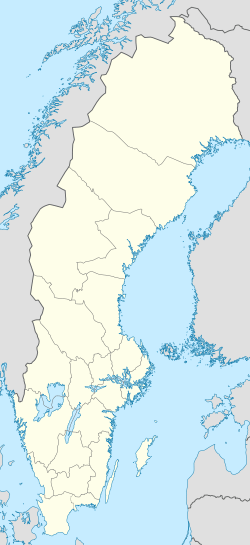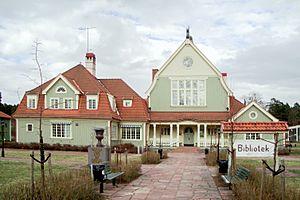Älvdalen facts for kids
Quick facts for kids
Älvdalen
|
|
|---|---|
| Country | Sweden |
| Province | Dalarna |
| County | Dalarna County |
| Municipality | Älvdalen Municipality |
| Area | |
| • Total | 3.02 km2 (1.17 sq mi) |
| Population
(31 December 2010)
|
|
| • Total | 1,810 |
| • Density | 600/km2 (2,000/sq mi) |
| Time zone | UTC+1 (CET) |
| • Summer (DST) | UTC+2 (CEST) |
| Climate | Dfc |
Älvdalen (which means "the river valley") is a small town in Sweden. It is the main town in the Älvdalen Municipality in Dalarna County. In 2010, about 1,810 people lived there.
A famous item from Älvdalen is a huge granite vase. It is about 4 meters (13 feet) tall! This vase, called the Älvdalen Vase, was made here in 1839. It was a gift from the Swedish King Charles XIV John of Sweden to the Russian Emperor Nicholas I of Russia. You can see it today in the Summer Garden in Saint Petersburg, Russia.
Close to Älvdalen, you can find the Hykjebergets Nature Reserve. This beautiful nature area was officially opened by Prince Carl Philip and Princess Sofia in 2016.
The Unique Language of Älvdalen
The original language spoken in Älvdalen is called Elfdalian. It is a very special language. Even though it has changed over time, it still has many old features from Old Norse. Old Norse was a language spoken by Vikings a very long time ago. Most other languages in Northern Europe have lost these old features, but Elfdalian has kept them.
Today, most people in Älvdalen speak a local way of Swedish. This is also the main language used by the local government.
Älvdalen's Weather
Älvdalen has a subarctic climate. This means it has very cold winters and cool summers. It is located deep inside the Scandinavian Peninsula, far from the sea. Because of this, the temperatures can change a lot between seasons. The climate here is quite similar to Skellefteå, a city much further north.
Since Älvdalen is in a river valley, the air can get trapped. This often leads to something called "temperature inversion," where the air near the ground gets very cold. This makes the area prone to harsh freezing. Compared to Mora, which is about 35 kilometers (22 miles) southeast, Älvdalen can be much colder. Mora is lower and closer to the slightly warming effect of Lake Siljan.
| Climate data for Älvdalen (2002–2021 averages); extremes since 1968 | |||||||||||||
|---|---|---|---|---|---|---|---|---|---|---|---|---|---|
| Month | Jan | Feb | Mar | Apr | May | Jun | Jul | Aug | Sep | Oct | Nov | Dec | Year |
| Record high °C (°F) | 8.3 (46.9) |
11.2 (52.2) |
16.6 (61.9) |
24.5 (76.1) |
28.2 (82.8) |
33.0 (91.4) |
31.8 (89.2) |
33.9 (93.0) |
26.5 (79.7) |
22.2 (72.0) |
14.5 (58.1) |
10.1 (50.2) |
33.9 (93.0) |
| Mean maximum °C (°F) | 5.0 (41.0) |
6.1 (43.0) |
11.6 (52.9) |
17.5 (63.5) |
23.9 (75.0) |
26.5 (79.7) |
28.0 (82.4) |
25.9 (78.6) |
21.2 (70.2) |
14.9 (58.8) |
9.3 (48.7) |
5.3 (41.5) |
29.2 (84.6) |
| Mean daily maximum °C (°F) | −3.6 (25.5) |
−1.2 (29.8) |
3.9 (39.0) |
9.8 (49.6) |
15.2 (59.4) |
19.7 (67.5) |
22.1 (71.8) |
19.8 (67.6) |
15.2 (59.4) |
8.0 (46.4) |
1.9 (35.4) |
−2.1 (28.2) |
9.1 (48.3) |
| Daily mean °C (°F) | −7.7 (18.1) |
−5.9 (21.4) |
−1.7 (28.9) |
3.6 (38.5) |
8.9 (48.0) |
13.3 (55.9) |
15.8 (60.4) |
14.0 (57.2) |
9.8 (49.6) |
4.8 (40.6) |
−1.4 (29.5) |
−5.9 (21.4) |
4.0 (39.1) |
| Mean daily minimum °C (°F) | −11.8 (10.8) |
−10.5 (13.1) |
−7.3 (18.9) |
−2.7 (27.1) |
2.6 (36.7) |
6.8 (44.2) |
9.5 (49.1) |
8.1 (46.6) |
4.4 (39.9) |
−0.3 (31.5) |
−4.7 (23.5) |
−9.7 (14.5) |
−1.3 (29.7) |
| Mean minimum °C (°F) | −24.6 (−12.3) |
−23.3 (−9.9) |
−19.3 (−2.7) |
−9.6 (14.7) |
−4.5 (23.9) |
0.2 (32.4) |
2.8 (37.0) |
0.7 (33.3) |
−2.6 (27.3) |
−9.1 (15.6) |
−15.4 (4.3) |
−21.5 (−6.7) |
−26.8 (−16.2) |
| Record low °C (°F) | −37.3 (−35.1) |
−35.7 (−32.3) |
−32.4 (−26.3) |
−19.9 (−3.8) |
−7.9 (17.8) |
−3.6 (25.5) |
−0.5 (31.1) |
−3.2 (26.2) |
−9.5 (14.9) |
−20.3 (−4.5) |
−27.0 (−16.6) |
−35.7 (−32.3) |
−37.3 (−35.1) |
| Average precipitation mm (inches) | 40.4 (1.59) |
26.8 (1.06) |
23.7 (0.93) |
26.6 (1.05) |
58.5 (2.30) |
68.6 (2.70) |
83.2 (3.28) |
82.9 (3.26) |
50.1 (1.97) |
55.7 (2.19) |
47.6 (1.87) |
37.1 (1.46) |
601.2 (23.66) |
| Source 1: SMHI Open Data | |||||||||||||
| Source 2: SMHI climate data 2002–2021 | |||||||||||||
See also
 In Spanish: Älvdalen para niños
In Spanish: Älvdalen para niños




